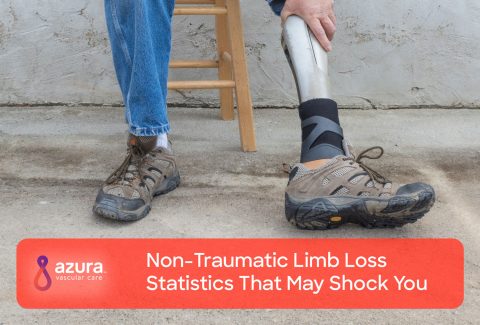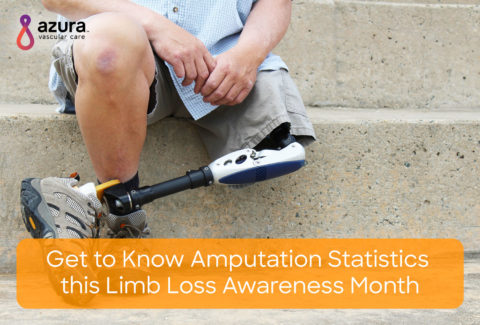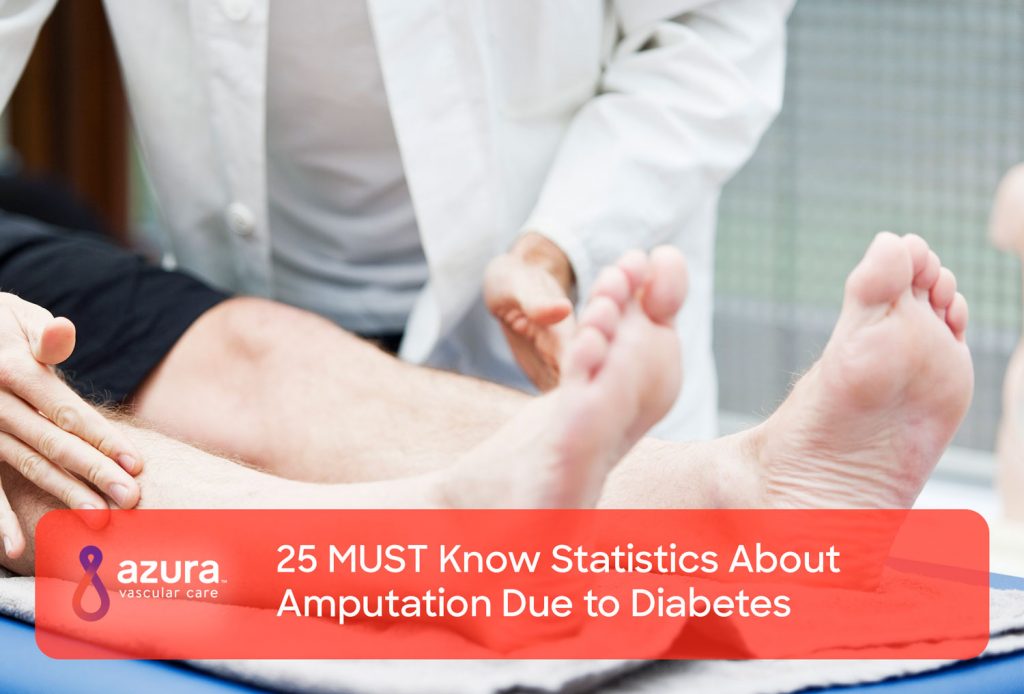
Diabetes is a common medical condition in the United States – at least 9% of Americans are living with diabetes.[i]
Diabetes affects many areas of the body. If you’ve been diagnosed with diabetes, you need to be aware of your feet and watch out for diabetic foot ulcers. What are diabetic foot ulcers? Diabetic foot ulcers are sores that develop on your feet, and they can develop even from seemingly trivial injuries to the feet. Diabetic foot ulcers are a common cause of amputation due to diabetes.
If you’re wondering about diabetic foot amputation statistics, be warned: these statistics may seem discouraging. But keep in mind that information can be empowering, and these stats emphasize the importance of seeking medical care for foot ulcers as soon as you notice them. The list also highlights the close connection between peripheral artery disease (PAD), which involves the blockage of the blood vessels in the legs, and what the likelihood is that diabetic foot ulcers will heal.
Hopefully this knowledge will remind you to take care of your feet if you have diabetes. If you have a diabetic foot ulcer that hasn’t been treated, show it to your doctor as soon as possible.
25 Statistics Every Person Living with Diabetes Must Know About Amputation
Diabetic Foot Ulcers and Amputation
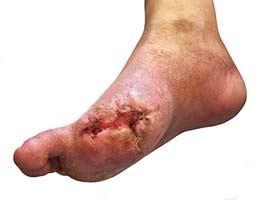 There are some surprising statistics about how common diabetic foot ulcers are, how often they can lead to amputation and the ultimate cost of having a foot ulcer that results in an amputation.
There are some surprising statistics about how common diabetic foot ulcers are, how often they can lead to amputation and the ultimate cost of having a foot ulcer that results in an amputation.
1. A foot ulcer is the initial event in more than 85% of major amputations that are performed on people with diabetes.[ii]
2. In the United States, every year about 73,000 amputations of the lower limb not related to trauma are performed on people with diabetes.[i]
3. Of non-traumatic amputations in the United States, 60% are performed on people with diabetes.[i]
4. Throughout the world, it’s estimated that every 30 seconds one leg is amputated due to diabetes.[iii]
5. 10% of people with diabetes have a foot ulcer.[iv]
6. The lifetime risk of developing a foot ulcer for someone with diabetes is 25%.[iv]
7. Every year, about 1-4% of people with diabetes develop a new foot ulcer.[iv]
8. Between 10-15% of diabetic foot ulcers do not heal.[v]
9. Of diabetic foot ulcers that do not heal, 25% will require amputation.[v]
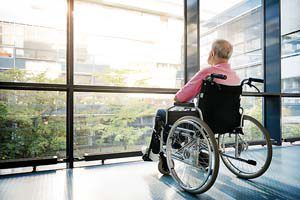 10. In one study, research showed that following an amputation, up to 50% of people with diabetes will die within 2 years.[ii]
10. In one study, research showed that following an amputation, up to 50% of people with diabetes will die within 2 years.[ii]
11. In the United States, the cost to care for diabetic foot ulcers is about $11 billion per year.[vi]
12. Approximately 20% of hospital admissions in people with diabetes are due to foot ulcers.[iii]
13. After a lower limb amputation someone with diabetes remains in the hospital an average of 9-12 days.[vii]
RELATED: Cases Where Non-Healing Diabetic Foot Ulcers Occur
Risk Factors for Diabetic Foot Ulcers
Diabetic foot ulcers are preventable. There are certain conditions that increase the chance an ulcer will develop as well as if it can be healed.
14. Diabetic neuropathy alone causes between 45-60% of diabetic foot ulcers.[viii]
15. PAD and neuropathy are involved in approximately 45% of diabetic foot ulcers.[viii]
16. Men with diabetes over the age of 60 are more likely to develop foot ulcers.[viii]
17. Waiting to be seen by a doctor for a diabetic foot ulcer for longer than 6 weeks can increase the likelihood that the ulcer will result in an amputation.[ix]
 18. The risk for amputation may be decreased by up to 75% if a team specializing in the care of diabetic foot ulcers is involved. x This team may consist of specialists in wound care, diabetes podiatry, infectious disease, and a vascular specialist.
18. The risk for amputation may be decreased by up to 75% if a team specializing in the care of diabetic foot ulcers is involved. x This team may consist of specialists in wound care, diabetes podiatry, infectious disease, and a vascular specialist.
19. Up to 50% of diabetic foot ulcer cases can be prevented with appropriate education focused on teaching people with diabetes how to care for their feet.[iii]
Diabetic Foot Ulcers and Infection
Infection is one of the leading causes of amputation due to diabetes-related foot ulcers.[iv]
20. An ulcer present for more than 30 days is more likely to become infected.[xi]
21. Osteomyelitis, which is an infection in the bone, is seen in 15% of people with diabetic foot ulcers.[xii]
PAD and Diabetic Foot Ulcers
PAD can be treated by rerouting blood flow, either with bypass surgery or through a minimally invasive procedure. Improving the flow of oxygen and nutrients to an ulcer can aid in healing.
22. One year after PAD treatment, up to 70-90% of limbs affected by PAD and diabetic foot ulcers will be saved from amputation.[xiii]
23. One year after PAD treatment, it’s estimated that up to 60% of ulcers in people with diabetes and PAD are healed.[xiii]
24. Among people with a diabetic foot ulcer and PAD, improving the blood flow within 8 weeks after initial evaluation by a doctor is more likely to lead to healing of the ulcer.[xiv]
25. About 20% of patients with symptoms from PAD have diabetes.[iv]
It’s important to keep in mind that early intervention and treatment of PAD is the most effective way to potentially avoid amputation. Waiting too long to seek treatment can severely limit your options. If you’re concerned about having surgery to treat your PAD, ask your doctor about less invasive alternatives. There are several minimally invasive peripheral artery disease treatment options you can look into, including procedures such as, atherectomy or angioplasty and stenting.
Diabetic foot ulcers are serious and can lead to amputation. If you have diabetes and you still haven’t shown your foot ulcer to your doctor, please set up an appointment now.
Sources:
i Centers for Disease Control and Prevention. National Diabetes Statistics Report: Estimates of Diabetes and Its Burden in the United States, 2014, Atlanta, GA: US Department of Health and Human Services; 2014. http://www.cdc.gov/diabetes/data/statistics/2014statisticsreport.html (accessed 8/1/2016)
ii Brownrigg, J.R.W., Apelqvist, J., Bakker, K., Schaper, N.C., and Hinchliffe, R.J., Evidence-based managed of PAD & the Diabetic Foot. Euro J Vasc and Endovasular Surg, 2013. 45(6): p. 673-681. http://www.ejves.com/article/S1078-5884(13)00136-6/abstract (accessed 7/30/2016)
iii Yazdanpanah, L., Nasiri, M., Adarvishi, S., Literature review on the management of diabetic foot ulcer. World J Diabetes, 2015, 6(1): p. 37-53. http://www.ncbi.nlm.nih.gov/pmc/articles/PMC4317316/ (accessed 8/12/2016)
iv Wu, S., Driver, V., Wrobel J., and Armstrong D., Foot Ulcers in the Diabetic Patient, Prevention and Treatment. Vascular Health Risk Management. 2007 Feb; 3(1): 65-76. https://www.ncbi.nlm.nih.gov/pmc/articles/PMC1994045/(accessed 2/24/2017)
v Pemayun, T.G.D., Naibaho, R.M., Novitasari, D., Amin, N., Minuljo, T.T., Risk factors for lower extremity amputation in patients with diabetic foot ulcers: a hospital-based case–control study. Diabetic Foot & Ankle, 2015. 6:10.3402/dfa.v6.29629. doi:10.3402/dfa.v6.29629. http://www.ncbi.nlm.nih.gov/pmc/articles/PMC4673055/ (accessed 8/5/2016)
vi Verrone Quilici, M.T., de Sa Del Fiol, F., Franzin Vieira, A.E., Toledo, M.A., Risk Factors for Foot Amputation in Patients Hospitalized for Diabetic Foot Infection. J Diabetes Research; 2016, Article ID 8931508, 8 pages, 2016. doi:10.1155/2016/8931508 http://www.hindawi.com/journals/jdr/2016/8931508/ (accessed 8/12/2016)
vii Centers for Disease Control and Prevention. Average Length of Stay (LOS) in Days of Hospital Discharges for Nontraumatic Lower Extremity Amputation with Diabetes as a Listed Diagnosis, United States, 1988-2009. http://www.cdc.gov/diabetes/statistics/lea/fig2.htm (accessed 8/12/2016)
viii Boulton AJ, Kirsner RS, Vileikyte L. Clinical practice. Neuropathic diabetic foot ulcers. N Engl J Med. 2004;351:48-55. http://www.nejm.org/doi/full/10.1056/NEJMcp032966 (accessed 2/24/2017)
ix Margolis, D.J., Allen-Taylor, L., Hoffstad, O., Berlin, J.A., Diabetic Neuropathic Foot Ulcers. Diabetes Care, 2002, 25(10): p. 1835-1839. http://care.diabetesjournals.org/content/diacare/25/10/1835.full.pdf (accessed 8/4/2016)
x Lipski, B.A., Berendt, A.R., Cornia, P.B., Pile, J.C., Peters, E.J., Armstrong, D.G., Deery, H.G., Embil, J.M., Joseph W.S., Karchmer, A.W., Pinzur, M.S., Senneville, E., 2012 Infectious Disease Society of America clinical practice guideline for the diagnosis and treatment of diabetic foot infections. Clin Infect Dis, 2012, 54(12): e132-73. https://www.guideline.gov/summaries/summary/37220/2012-infectious-diseases-society-of-america-clinical-practice-guideline-for-the-diagnosis-and-treatment-of-diabetic-foot-infections (accessed 8/11/2016)
xi Malhotra, R., Chan C.S., Nather, A., Osteomyelitis in the diabetic foot. Diabetic Foot & Ankle, 2014, 5: 24445 – http://dx.doi.org/10.3402/dfa.v5.24445 (accessed 8/4/2016)
xii Hinchliffe, R.J., Andros, G., Apelqvist, J., Bakker, K., Fiedrichs, S., Lammer J., Lepantalo, M., Mills, J.L., Reekers, J., Shearman, C.P., A systematic review of the effectiveness of revascularization of the ulcerated foot in patients with diabetes and peripheral arterial disease. Diabetes/Metabolism Research Reviews, 2012, 28(Suppl. 1): p. 179-217. http://lup.lub.lu.se/record/2348733 (accessed 8/12/2016)
